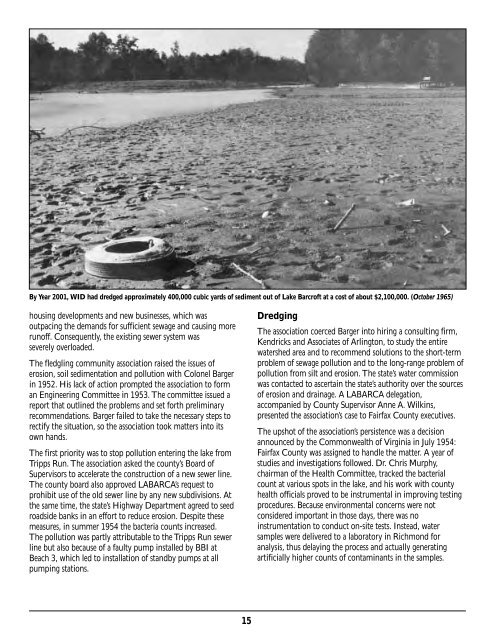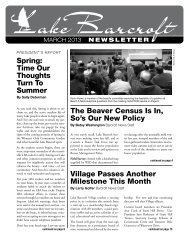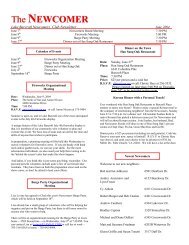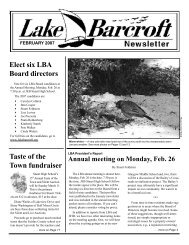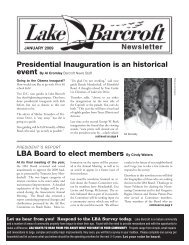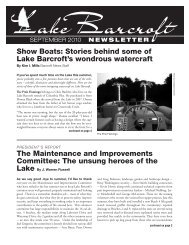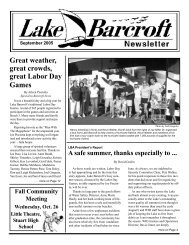Lake Barcroft History Book
Lake Barcroft History Book
Lake Barcroft History Book
You also want an ePaper? Increase the reach of your titles
YUMPU automatically turns print PDFs into web optimized ePapers that Google loves.
By Year 2001, WID had dredged approximately 400,000 cubic yards of sediment out of <strong>Lake</strong> <strong>Barcroft</strong> at a cost of about $2,100,000. (October 1965)<br />
housing developments and new businesses, which was<br />
outpacing the demands for sufficient sewage and causing more<br />
runoff. Consequently, the existing sewer system was<br />
severely overloaded.<br />
The fledgling community association raised the issues of<br />
erosion, soil sedimentation and pollution with Colonel Barger<br />
in 1952. His lack of action prompted the association to form<br />
an Engineering Committee in 1953. The committee issued a<br />
report that outlined the problems and set forth preliminary<br />
recommendations. Barger failed to take the necessary steps to<br />
rectify the situation, so the association took matters into its<br />
own hands.<br />
The first priority was to stop pollution entering the lake from<br />
Tripps Run. The association asked the county’s Board of<br />
Supervisors to accelerate the construction of a new sewer line.<br />
The county board also approved LABARCA’s request to<br />
prohibit use of the old sewer line by any new subdivisions. At<br />
the same time, the state’s Highway Department agreed to seed<br />
roadside banks in an effort to reduce erosion. Despite these<br />
measures, in summer 1954 the bacteria counts increased.<br />
The pollution was partly attributable to the Tripps Run sewer<br />
line but also because of a faulty pump installed by BBI at<br />
Beach 3, which led to installation of standby pumps at all<br />
pumping stations.<br />
15<br />
Dredging<br />
The association coerced Barger into hiring a consulting firm,<br />
Kendricks and Associates of Arlington, to study the entire<br />
watershed area and to recommend solutions to the short-term<br />
problem of sewage pollution and to the long-range problem of<br />
pollution from silt and erosion. The state’s water commission<br />
was contacted to ascertain the state’s authority over the sources<br />
of erosion and drainage. A LABARCA delegation,<br />
accompanied by County Supervisor Anne A. Wilkins,<br />
presented the association’s case to Fairfax County executives.<br />
The upshot of the association’s persistence was a decision<br />
announced by the Commonwealth of Virginia in July 1954:<br />
Fairfax County was assigned to handle the matter. A year of<br />
studies and investigations followed. Dr. Chris Murphy,<br />
chairman of the Health Committee, tracked the bacterial<br />
count at various spots in the lake, and his work with county<br />
health officials proved to be instrumental in improving testing<br />
procedures. Because environmental concerns were not<br />
considered important in those days, there was no<br />
instrumentation to conduct on-site tests. Instead, water<br />
samples were delivered to a laboratory in Richmond for<br />
analysis, thus delaying the process and actually generating<br />
artificially higher counts of contaminants in the samples.


